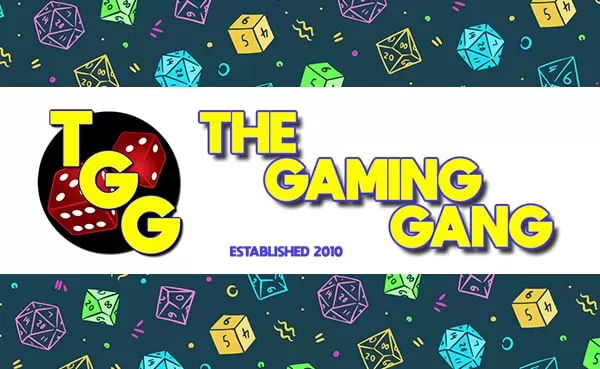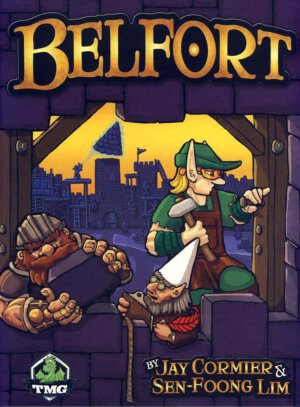Publisher: Tasty Minstrel Games
Designers: Jay Cromier and Sen-Foong Lim
Artists: Josh Cappel, Jay Cormier, Satya Hody, Sen-Foong Lim, and Hans-Georg Schneider
Year: 2011
Players: Two to five players
Ages: 13+
Playing Time: 90 to 120 Minutes
Category: Worker Placement/Area Control
Retail Price: $59.95
Ahhhh… Bureaucracy, you got to love it right? The construction of our newest city, Belfort, is starting off on the right foot in that department. It seems the proverbial left and right hands have managed to avoid talking to each other yet again. While the plans for the city are well laid out it appears that several contractors have been hired to build the city… However only one contractor will be awarded the key to the city upon it’s completion. This kind of notoriety will go a long way to securing future contracts so you want to make sure that contractor is you.
At the core of Belfort you will find a worker placement game. No, wait that’s not right. At the core of Belfort you will find an area majority game. Wait! It’s both and that’s where the brilliance (frustration) of the game lives and breaths. Turn order, for example, is only changed by using one of your actions. Do you select to go first so you’ll have the first choice of placement? (important in a worker placement game) Or do you choose to go last to be able to build after the other players and gain control over areas in the city, especially before scoring? (important in area majority games.) This is one of the many interesting decisions worked into the game where the only thing that is certain, is that you can not go first and last….which is ideally what you would like to do.
Interesting. I found myself using this word over and over again in reference to this game. You have to use your workers to get actions to help you such as:
Occupying one of the guilds that gives some of the best benefits in the game
Occupying previously built buildings for other benefits
Changing turn order (as mentioned above)
Recruiting more workers so you can have more actions next turn
Gathering resources without which you can not build anything
That’s a lot to get accomplished. Problem is, you start with only 3 elves and 3 dwarves. Most of the actions I spoke about will cost you gold in order to place your workers. So you have to manage your gold as well because income can be scarce and taxes can be high!
The flow the game feels very familiar. You place your workers, gather your resources, then take your actions. Basically speaking that makes up all you do in a round. At the end of the third, fifth and seventh rounds comes a scoring phase. There are only these 3 scoring phases to get your points and it’s been my experience that an average winning score is settling in around 30-40 points. Speaking of points that’s another one of the interesting elements in this game. Most games you feel the need to score every point you can possibly get. In Belfort, however, you find yourself not too upset when you miss a point or two. See for every 5 points you gain, the amount you have to pay in taxes is increased by one gold. This means you may be sitting pretty paying 2 gold in taxes at 15 points but if you accidentally pick up just one more point your taxes will increase to 3 gold a turn. It can really hurt to round the next corner pushing you up to the next tax bracket.
Now that you know you want points, and sometimes don’t mind missing a point, how do you go about getting them? During the 3 scoring rounds players are awarded points for area majorities in the 5 districts in the town as well as having majorities of workers. The districts offer up 5, 3 and 1 points for first, second and third place (third place only scores in a 4 or 5 player game.) The worker majorities only offer 3 and 1 points for first and second in the categories of elves, dwarves and gnomes. If any category is tied,the tied players both receive the next lower amount of points ala El Grande style tie scoring.
Sounds easy enough right? Well, as I said, this game is interesting and getting those points on the board is not as simple as one might think. While other area majority games give you some leeway with putting your influence onto the board, Belfort constricts you. During the actions phase you build up the city by constructing buildings. The construction availability comes in 3 varieties. Property cards from your hand which will give you benefits if you play your workers on them, the guilds on the board which will allow your workers to be placed freely or force other players to pay you to place theirs and the walls of the city that have no intrinsic benefit other than providing you one influence in that district. As you construct the property cards from your hand you place onto the board one of your property markers, however it must be placed in the building type you just built. If you develop a library you then must place your marker on a library, if you decided to build a pub you must place onto a pub. Trouble is, each district has only one of each of the building types. This limits your ability to influence specific districts based on the cards in your hand. Likewise, each district also only has one guild. Once the 5 guilds are built there’ll be no more of that happening. Walls then can allow you to get back into the fight for a district as they don’t require a card and each district has 2 wall segments.
With that, you have the main bits of the game. Sure, I glossed over things like the fact that if you have majority in each production area you earn a bonus unit of material making your distribution choices there interesting. The fact that there are 12 guilds in 3 categories but only 5 are used each game, keep the game both customizable and different with successive plays is interesting. The fact that you get points for gnomes, yet can only hire one per round and then only if you built a card that requires one, is interesting. The fact that you can monopolize or diversify your property cards giving you different benefits to tailor the game to your style of play is interesting.
Boiling it down I say that Belfort is an innovative area majority game that keeps things very tight and tense each and every scoring round. This is driven by a crushingly difficult decision making process found in the worker placement aspect of the game. While this looks like a cute, light hearted game don’t let it fool you. There is some serious weight behind this game but one that is well worth the time to buy and play, over and over again.
- Titan Comics for February 21st, 2018 - Feb 17, 2018
- The Gardeners and the Panda?: A Review of Takenoko - Jan 25, 2012
- You Made a Time Machine Out of a DeLorean? Back to the Future – The Card Game Reviewed - Jan 8, 2012














2 Comments
Nice review! Can’t wait to play this. Worker placement, area majority, good replayability, how can you go wrong…
I think it’s important to note that the guilds add re-playability not just in ‘changing’ up what’s available and therefore the relative values from game to game, but can also have significant impact to ‘play styles’ on how you approach the ‘turn order quandary’